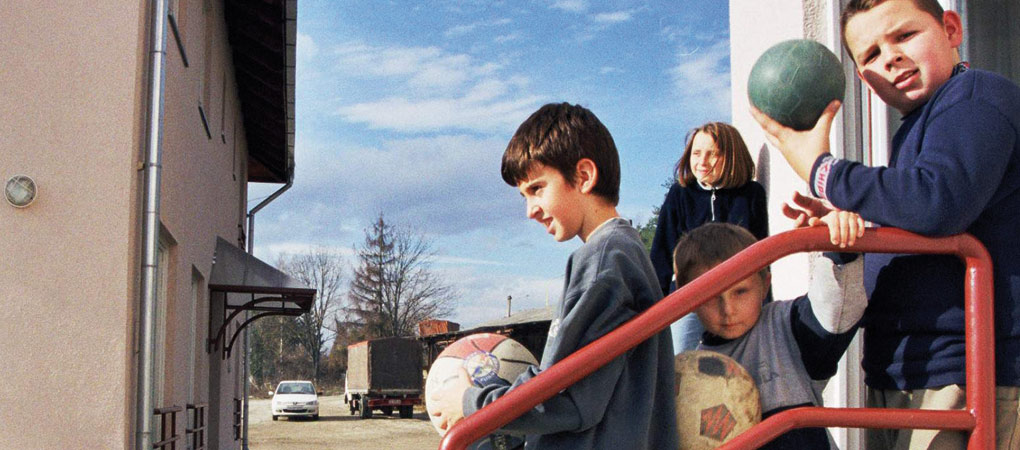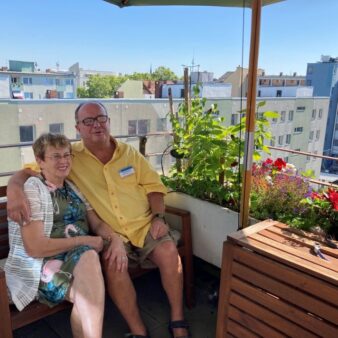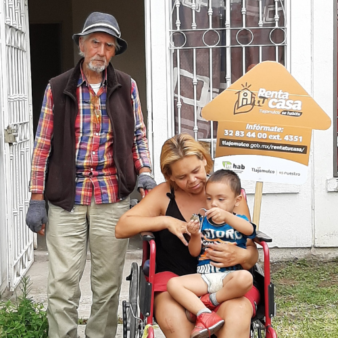The Housing Center is an NGO working to improve the housing conditions for socially vulnerable groups in Serbia, particularly refugees and internally displaced persons. Not only does the Housing Center construct new social housing units, it also helps to create a supportive environment for residents through the provision of a ‘host family’ in each of the small apartment blocks. The project is delivered in close cooperation with local municipalities and their centres for social work. To date 430 new apartments have been completed in 22 different municipalities and the project approach is now being implemented ever more widely.
Project Description
Aims and Objectives
The main purpose of the project is the integration of the most vulnerable refugees and internally displaced persons (IDPs) who are typically accommodated in collective centres or inadequate private accommodation, as well as the most vulnerable local population such as single parents, older people, victims of domestic violence and people who are in need of housing, through the provision of sustainable housing solutions.
Programme context
Serbia has the highest number of refugees and IDPs in Europe. Since 1991, Serbia has received over 500,000 refugees from the conflict in Bosnia and Croatia and a further 220,000 IDPs from Kosovo. The overall political crisis has been accompanied by a deteriorated economy and stagnation due to ten years of economic decline and isolation by the international community. Although many refugees have now integrated into Serbia or returned, there are still 100,000 people with refugee status in Serbia. These refugees came from Bosnia and Croatia and for most of them it is impossible to return home; integration into Serbian society is seen to be the only answer. The IDPs from Kosovo are classed as IDPs rather than refugees as Serbia does not recognise Kosovo’s political independence. Both refugees and IDPs are mainly ethnic Serbs, although 40,000 of the IDPs are ethnic Roma.
Many of the refugees were accommodated in collective centres (refugee camps) that are now in the process of closure. Most of the residents remaining in these centres are unable to find their own housing and are dependent on external support. They are mainly single parents, older people, poor families and disabled persons; all were badly traumatised by their experiences in the war and the struggle to build a new life in a strange country, without any means of support. Most are unemployed and have limited access to job opportunities. Many other displaced people live in very poor quality private rental accommodation. It is recognised that adequate housing is the main obstacle to successful integration and dignified living.
Serbia does not have a system of affordable or social housing or an adequate housing policy in place and there is thus no institutionalised mechanism that would assist the vulnerable in solving their housing needs. More than 500,000 citizens of Serbia live in poverty (6.6 per cent), with the poorest being those in rural areas, refugees and IDPs, older people and the disabled. Serbia has the highest unemployment rate (18.8 per cent) in the region and there is currently a shortage of 100,000 housing units. Local municipalities are responsible for meeting the social needs of their citizens.
Key Features
The project has two main components – the construction of new social housing units and the creation of a supportive environment to assist the residents. The project is delivered in close cooperation with the local municipalities and the local centres for social work (CSWs). To date 430 new apartments have been completed in 22 different municipalities. The buildings are two-storey and well-built, reflect local building styles and are not at all institutionalised. All buildings are newly built rather than refurbished or converted and typically include six or eight apartments in one block. The buildings are designed to lifetime building standards and the ground floor apartments are barrier free and fully accessible. Special attention is given to common places such as communal rooms, laundries, terraces and outdoor space as these provide spots for regular social contact and exchange amongst the residents and within the neighbourhood.
The supportive environment is provided by a ‘Host (or Foster) Family’ within each apartment building. This is a socially vulnerable refugee/IDP with children and working capacity that is responsible for the other five or six households in the building. This host family lives in an apartment in the same way as other families in the building, and by sharing the everyday activities provides them with the daily assistance of a good neighbour. The host family helps facilitate the integration in the new social environment, the development of good neighbourly relations and a positive atmosphere in the building, as well as establishing contacts with external bodies and helping to provide a sense of security. The host family is also responsible for maintaining the common areas of the building and helping residents with their own maintenance. Each municipality decides on the payment to be made to the host family, and this ranges from rent-free living only to a salary with attached pension and health insurance. In no case is the payment generous, as state salaries are very low in Serbia.
The tenancies are reviewed annually to identify whether families are still considered to be socially vulnerable. If they are considered to be able to live independently the centre for social work will help them to find alternative accommodation for them. None of the residents have yet moved out of the accommodation, primarily due to the depth of vulnerability (60 per cent of all residents are not capable of working) and limited employment opportunities.
Participating local authorities are selected on the basis of need in terms of the number of refugees and IDPs and the depth of vulnerability, together with the ability to provide land and infrastructure and willingness to participate in the programme. Each municipality has a centre for social work, which is the basic unit of the social protection system in Serbia. The local centre selects the host families and provides training for the host family in communication, conflict management and supervision of those with mental and physical ill health. It draws up individual agreements with every resident, defining goals and expectations and the kind of support needed in taking on the role of tenants. The criteria for selection of families are defined by the municipality and are made widely known. The project is still in progress and is now being implemented more widely.
Covering costs
The first SHSE projects were financed by Swiss Development and Cooperation (SDC) and support has since been received from a range of different international agencies, which are currently funding several ongoing SHSE projects in order to address the protracted refugee situation in south-east Europe. The Government of Serbia financed several SHSE projects from its own budget through the National Investment Plan for 2009. Local municipalities contribute approximately 30 per cent of the cost of the construction works with provision of the land and infrastructure.
In order to keep costs down in these early stages floor areas were comparatively small (12m2 per person), but these have increased in more recent projects to 13.5m2 – 15m2 per person. The average cost per dwelling unit is US$20,227 or US$553/m2.
Impact
- The SHSE project has significantly improved the quality of life for the 430 households who now have a safe home from which to rebuild their lives. Before living here most families had moved at least five times in ten years. Evaluation surveys carried out by the EU funders have shown that 100 per cent of the residents expressed a great sense of relief and an improved sense of security in having a stable place to live.
- People are healthier and safer than before when they lived precarious lives, with many instances of poor mental health arising from the pressures of collective living and uncertainty about the future.
- A large number of municipalities in Serbia are now interested in this form of protection as it has proved to be an efficient, convenient and cost-effective approach to social housing for the most vulnerable.
- Future European funding for housing for refugees requires that the housing be developed within a supportive environment.
- Many people have now been granted full Serbian citizenship. Currently, 37 per cent of the residents have become Serbian citizens and the remaining 63 per cent are going through the lengthy process of obtaining it
- Residents are given the opportunity to live independently and to realise their potential. Hence, the residents depend less on institutional help and have a better quality of life than that provided in an institution
- The SHSE projects triggered a wide stakeholder discussion on housing policy in general, and social housing in particular, and the Law on Social Housing is expected to be passed in mid-2009, which should lead to the implementation of national and local social housing policy
Why is it innovative?
- The provision of support alongside housing to ensure that very vulnerable members of society are able to begin to acquire some stability in their lives, become more involved in their communities and look forward to a more positive future.
- The role of the host families and the centres for social work in helping to create an inclusive and integrated society.
- The degree of cooperation with local institutions and the development of their physical and financial input, which has in turn led to the building of robust NGO/government partnerships.
- The deinstitutionalised and decentralised way in which the programme is organised and delivered.
What is the environmental impact?
- Local construction materials are used in the construction of the apartments
- The buildings are thermally insulated and energy-efficient. Wherever possible they have remote natural gas central heating.
- The buildings are located close to the traffic network and public transport.
Is it financially sustainable?
- The local municipality is the key guarantor of financial sustainability as it is the owner of the buildings and apartments and has numerous roles in this project. All municipalities have made an official decision that SHSE should have an extended right of social protection at the local level. The decision means that future support for the work of SHSE and the buildings is guaranteed.
- Job opportunities are generated for host families. The project has also indirectly contributed to the employment of others. The centres for social work put special emphasis on the support in providing work-capable residents with employment. The social integration process helps people to get in touch with other members of the local community, which all helps to improve their personal networks and increase their chances of finding work.
- The tenants do not pay rent, only their utility bills. Additional help is available from the municipality with these costs if the household is living on the minimum benefit level.
What is the social impact?
- The supportive role of the host families and the centres for social work is designed to facilitate greater community cooperation and integration.
- Alongside assisting the refugees or IDPs, the programme ensures that 20 per cent of accommodation is allocated to socially vulnerable local people. This helps to encourage the support of local municipalities, but more importantly it helps to reduce any local tensions that may emerge over outsiders being given priority.
- Strategies have been developed and implemented for conflict resolution between residents, inside the family and within the local community. For example, respect for the house and community is important and this is explained to incoming residents to reduce any possible sources of tension.
- Training is carried out to improve the chances of obtaining employment/income, including for women as well as providing support for children and young people.
- Special programmes for men are provided to enhance family and business integration.
- Living in the SHSE apartments has led to greater equality as the stigma of living in the collective centres is eliminated. The apartment blocks are constructed to a similar style and quality to other local housing in order to avoid stigmatisation and social segregation.
- Psycho-social support is provided to help people adjust to independent living, as well as help with personal and financial issues to build confidence.
Barriers
- In Serbia housing is not seen as a political objective and it has neither a system of affordable or social housing nor a housing policy in place. This has forced people to find a solution to their housing needs under market conditions. There is no exception for the most vulnerable and this is not feasible for many of them. In order to establish the SHSE a new institutional structure needed to be created and a link with the Ministry of Labour and Social Policy was developed.
- Long-term residence in the collective centres (sometimes more than 15 years) meant that some of the persons had lost their personal initiative. This was overcome with the participatory process of planning and implementation that sought to create a mutual understanding and a sense of partnership.
- Fixed thinking of stakeholders had to be overcome to encourage involvement. Establishing political will and encouraging municipalities to take on financial responsibility was achieved through discussion and persuasion.
- Distrust of public ownership of housing in a society where owner occupation is seen to provide the only certainty is beginning to be overcome as more social housing is provided.
- Finding the funds to carry out the work required courage and conviction by municipalities. The project was seen to be expensive, particularly with the provision of communal facilities and space, and only benefitted a small number of local people (as compared to the non-local IDPs).
- Initial administrative delays in getting the project going were overcome with the dedication and conviction of SDC who were committed to getting the project going. After 2004 it became easier, once the first results were visible.
- Political problems related to political instability, including frequent shifts in power and the demotion of politicians acting as project partners and conflict in the political parties.
Lessons Learned
- Enthusiasm and conviction gave positive results to project implementation and ensured recognition, making the implementation process feasible.
- Importance of allowing time for introducing and effecting change, for building a community, even within a small collective building and for the correct evaluation of the results and their recognition.
- The value of solidarity – a very simple but powerful idea that is often overlooked or dismissed.
Evaluation
The results of the project are monitored on a regular basis, thoroughly recorded and incorporated in subsequent projects. The first major monitoring by SDC took place in 2005 to look at the social aspects, physical structure and legal framework. Subsequent monitoring takes place by the various EU funding agencies at various times. A further independent evaluation is to be commissioned by the Housing Center in 2009.
Transfer
In Serbia the project has been implemented in 22 out of 161 municipalities and is now going to be funded by the national government and extended to more municipalities. Municipalities are increasingly working together in the local areas as a result of the contacts established through the SHSE project. The centres for social work have established a strong network, where they can meet to exchange experience and encourage the development of similar successful approaches in other areas.
The SHSE approach has been implemented by other donors, for example the UNDP and the Italian Government in the work they are carrying out in Kragujevac. SDC has introduced the successful experience of SHSE to the countries of the South Caucasus, including Armenia and Georgia. Two projects have been developed in Armenia, adjusting the Serbian example to meet local individual needs. The Armenian partners receive advice and support from the staff of the Housing Center in Serbia. A pilot project using a similar approach was started in Tbilisi, Georgia in 2007.



